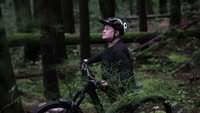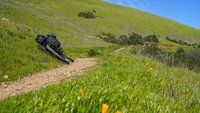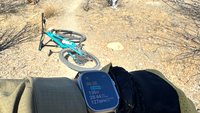I am writing a MTB Cypress Stewards for Advanced Trails Position Statement. In it I describe generally the evolution of the sport, how that has impacted riding styles, and thus trail design, and I tie this together to the terrain of the mountain slope and differentiate Old School and New School.
I am writing this for the District of West Vancouver. Here are some excerpts that I think are timely to this conversation. Please provide constructive comments to me directly at gberg at mtbcypress.ca and remark here.
Excerpts:
[INDENT]Advanced trails must exist and be maintained inside a trail management context that realizes the terrain of Cypress is a form that dictates the inherent trail difficulty. Standardized Management Practices as documented in literature such as Managing Mountain Biking, IMBAs Guide to Providing Great Riding (International Mountain Biking Association, 2007) speak toward a terrain context that is vastly different than the reality of the terrain found on Cypress.
Understanding the unique aspects of Cypress terrain, riding styles and trends, and the current rider experience level will assist the audience in assessing the options within their decision making realities.
Important considerations at this pre-planning stage of the Upper Lands Communities and the launch of the DWV Parks Trail Master Plan process are to understand the nature of the sport, and how the sports trends will interface with the terrain realities- and therefore the existing trails- including erosion and maintenance mitigation; trail interconnectedness from a rider perspective; and the interfacing of advanced trails within the community planning and development plans.[/INDENT]
MORE
[INDENT]In the context of the North Shore experience builders built the early trails that spawned much of the Freeride attitude, and the subsequent equipment engineering. Freeride by definition does not always mean ladders and skinnies, though they could be included. Freeride could include peddling up to a trail, or it could involve using a car or truck to shuttle to the top of the road where trails start for a Downhill gravity fed experience. So it is important to understand the context when these terms are used.
Most, if not all, bicycle companys in the past have done product testing on the North Shore mainly since the terrain is such that it abuses and stresses the components the most in the least amount of time. The initial trails created during that time were trails focused on slower paced Technical skills approach, within the mountain bike engineering capabilities of the time:
[INDENT]Historically, most of the trails weve ridden were far from homogenized because they werent designed with mountain bikes in mind. Mountain biking as we know it didnt exist before the 1980s and didnt gain widespread popularity until the 1990s (Fisch, 2013)
As mountain biking has grown, so have our skills as bikers; combine that with the improvements in technology, and theres very little which cant be ridden. (Fisch, 2013)[/INDENT]
These early trails on the North Shore are generally described as Old School trails: steep, rocky, and possibly North Shore style of ladders and skinnies. There was a large degree of technical skill involved to ride these trails. Over time, as mountain biking grew in popularity, and the engineering and suspension technologies adapted which allowed more and more difficult terrain to be ridden, it was inevitable that there would become a time where there would be a standardization, or homogenization, of trails as the sport expanded into the mainstream:
[INDENT]Now that mountain biking has a large, and growing, following, some new trails are being designed specifically for mountain biking. This usually means a certain grade, curves of a certain shape, often including berms, and routing over certain obstacles, but around other obstacles. Many of these new trails end up being very similar to each other. This doesnt just pertain to new trails; as older trails require reroutes, the replacement sections often take on this standard character. (Fisch, 2013)[/INDENT]
This trail typology is typically described as Flow as the character of the trail is focused on sustained movement of the bike over time. One analogy is to think of it as a bobsleigh track for bikes in amongst the trees on dirt and rock.
As the Flow trails occurred after the initial Technical Old School type trails the flow trails are now commonly described as New School:
[INDENT]While it can be great fun to hit a purpose-built mountain bike trail specially designed to maximize and maintain flow, theres a special satisfaction that comes with cleaning that craggy old bike-hostile trail with the inconvenient root garden and the super-tight, v-shaped switchbacks with rock drops right at the crux of the turns. I believe eliminating the latter and replacing it with the former chips away at an important part of the soul of our sport. (Fisch, 2013)[/INDENT]
An example of Fischs craggy old bike-hostile trail described above is found on Cypress and is called S[HTML_REMOVED]M.
Presently there exists on the North Shore mountains examples of each trail style type:
Technical Old School trails;
Flow New School trails.[/INDENT]
MORE
[INDENT]The North Shore has three main destination mountains for biking: Fromme, Seymour, and Cypress. Each mountain has unique terrain and mountain biking trail experiences. The North Shore is one of the few places in the world in such close proximity to a population base providing such a range of varying terrain and difficulty levels. This is why the North Shore of Vancouver is known internationally and revered by many as being a destination to ride on the way to or from Whistler.
Not all trails share the necessary terrain required for a technical Old School trail, or vice versa for a flow New School trail, based on the inherited original terrain underneath the trail, as this is more generally dictated by the geography of the mountain slope itself.
The technical Old School trails are typically the current unsanctioned, somewhat unmaintained, trails in existence. They, by their nature, tend to be the last vestiges of advanced terrain unsuitable for the wider, more moderately skilled, average riders of mountain bikes. Within the Vancouver area most of these trails now exist only on Cypress mainly due to the advanced terrain realities of that mountain slope.
The flow New School trails are typically the types of trails that have been newly built within the last five years, or modified into existing older trails where possible, ex. Espresso on Fromme. The terrain realities on Fromme and Seymour differ to that of Cypress- the terrain found on these two mountain slopes to the east is arguably more moderate and favor a more flow New School trail system.
The more moderate the original terrain, the more moderate the rider experience and skill that is required to ride the trail- all things equal. The more moderate the rider experience necessary for a trail, the more rider volume. Think of a normal Bell Curve within Grade School, you have the majority of riders at a certain level.
The trail type desired- technical Old School or flow New School- determines largely the specific trails ridden for most riders. Every trail has a personality, every trail requires certain skills- either a rider has them or not. Many riders differentiate trails by technical of flow and will ride trails they feel comfortable on. This is a key understanding: Riders censor themselves to their own comfort and fun level of trails available and will SEEK OUT those trails to ride.[/INDENT]
MORE
[INDENT]The recent past has seen more Novice, Beginner, and Intermediate riders tend to gravitate towards the flow New School trails of Fromme and Seymour, as they are typically easier and more forgiving to ride as there are fewer features requiring a technical ability to ride.
Think of technical ability to be a blend of athleticism, bike control, and trail seat time experience. Trail seat time experience is like that of a driver reading the road surface in a snowy environment (tires on the road allows a driver to control the car tires of mountain bike allows a rider to control the bike on wet rock, slippery roots, or soft dirt)- it is the awareness and experience one has that allows them to correctly read the surface in order to control their traction and movement.
It is a fact that Cypress trails have mostly steep original terrain, consisting of largely technical descents, which have an inherent level of advanced difficulty. More recently built flow New School trails can also create difficulty - but there is no substitution for original terrain.
The key distinctions (simplified) are these:
1. Cypress Trail Perceptions versus Fromme / Seymour Trail Perceptions
2. Technical Old School versus Flow New School
3. Original Advanced Terrain versus Original Moderate Terrain
4. Existing Advanced Challenge versus Built Moderate Challenge
The natural, largely un-built, terrain with its inherent level of advanced difficulty: it cannot be replicated anywhere else in the world so close to a city.[/INDENT]
MORE
[INDENT]There was a time where the higher the stunt in the air, the skinnier the lumber, the larger boulder drop onto a back wheel with elastomer suspension, the greater you were as a North Shore rider.
As bikes changed, and riding styles changed, the measurement of riding popularity has also changed: the slow North Shore technical riding started to give way to faster technical open space riding, exemplified by the form of Red Bull Rampage:
[INDENT]It's what inspired the folks at Red Bull to host the first ever Red Bull Rampage, which, if you think about it, might have been the main contributor to the fade on freeride's original gleam. Now it was a competition. Now you weren't freeriding anymore. Now your style and your line choice and the amplitude of your air counted for something.
Just look at what ensued: slopestyle competitions that struggle to find the sweetspot between a dirt jump competition and a big mountain competition
Sure, it's just a name, but is Crankworx really a freeride competition?
So how do we qualify the evolution? Street, dirt jump, bike park, downhill, enduro, slopestyle, these are the children of freeride for the most part. (Scott)[/INDENT]
This evolution in riding, and the accompanying large competition event inspired wow factor of a faster, flowier, style of riding, with big fantastic jumps and crazy tricks captured on video and cheered on by crowds is transforming the trails desired by some riders. As indicated above, a moderate flow New School trail is more forgiving so has more attractiveness for the less skilled riders but that is not to say that an advanced flow New School trail cannot be built. One recently was and it was called Never Never Land.
[/INDENT]
LASTLY
[INDENT]Most riders want to increase their riding skills, so the beginner riders will eventually seek out intermediate (it is the natural progression of basic skills on a bike that this naturally occurs); the intermediate riders could eventually seek out advanced (should they wish to seek a more exciting trail experience); the advanced rider might seek out expert (should their advanced biking abilities and personal risk tolerance allow). Note that each rider will, at some point, say they are happy with what they are riding, and the enjoyment gained, and will continue to ride at that level of ability.
So there is a choice to be considered in terms of the trail type(s) to be supported on Cypress. Technical Old School; Flow New School; or a blend; which impact a wide range of variables-
1) Riders Perception of trail style type availability will impact Rider Volumes for that trail style type;
2) Rider Volume increases as trail difficulty perceptions/realities decrease;
3) Rider Volume decreases as trail difficulty perceptions/realities increase;
4) Trail Style Popularity impacts Rider Supply demanding that Trail Style;
5) Higher rider volumes increase trail costs;
6) Lower rider volumes decrease trail costs;
7) Higher rider volumes may increase perceived liability risk;
8) Lower rider volumes may decrease perceived liability risk;
9) Rider Volumes impact parking requirements and economic spin offs;
[/INDENT]
Like I say, remarks here, but specific corrections or criticisms, email gberg at mtbcypress.ca







